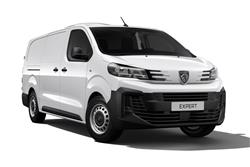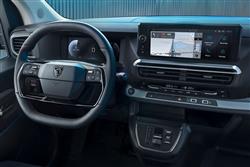Peugeot Expert - ABC Leasing
How will you view?
This is a sample, showing 30 seconds of each section.
YOUR RIGHT HAND VAN?(some text hidden)
By Jonathan Crouch
Ten Second Review word count: 39
With style, size and technology now on its side, the improved version of Peugeot's third generation Expert has much to offer if you're looking for a versatile medium range mid-sized van. There are diesel and full-EV versions on offer.
Background word count: 227
Want a job done properly? Then call in an Expert. In this case, we're talking LCVs, mid-sized ones to be exact. This is Peugeot's entry in the volume medium-range van sector, led comfortably for UK market sales by the Ford Transit Custom, but also populated by many other segment big-hitters. Taking all of those on isn't something you'd want to do single-handed, so the French brand has chosen to share this design not only with its partner Citroen's Dispatch model, but also with Vauxhall's Vivaro, Fiat's Scudo and even a brand outside the Stellantis conglomerate, Toyota with their Proace: all these vans share the same platform and basic design. Earlier generation versions of this Expert didn't significantly trouble the main players in this segment - namely the first generation model of 1996 and the second generation version of 2007. The MK3 'K0'-series model though, launched back in 2016, got itself sorted out, with more sophisticated design and larger load volumes that still rival anything in the class. A full-EV version, the E-Expert, arrived in 2020 and the whole range was usefully updated in early 2024 to create the LCV we're going to look at here. You get clever design, proven powertrains and low running costs in a package that certainly works on paper. Whether it'll cut the mustard day-in-day-out though is what we're here to find out.
Driving Experience word count: 497
So, do you get an Expert drive experience? Well, let's start with powertrains. As with its various design clones, engine choice in this Peugeot is pretty straightforward, provided you've a clear idea of the kind of work you want it to do. If your needs are mainly based around lighter loads and short distance urban work, then the entry-level 120hp 1.5-litre BlueHDi 120 unit (paired with manual transmission) may well be quite sufficient. Otherwise, you'll probably be looking at the 2.2-litre BlueHDi diesel with 150hp, which is what we're trying here with a manual gearbox but which also comes with the option of 8-speed EAT8 automatic transmission. This 2.2-litre diesel unit also comes at the top of the line-up in auto-only 180hp form. There's also a full-electric version, the E-Expert, which now offers a 230 mile driving range from its 75kWh battery. A key factor behind the success of previous generation Expert models has been found in the way that this French LCV is able to remain compact and wieldy in the manner of smaller, more car-like vans from the class below. This MK3 model's bigger of course than those older designs, but it retains much of that same usability around town and rides much better thanks to supple suspension and a stiff EMP2 platform. Special wishbone filtering dampens the impacts of our country's terrible tarmac and the variable stiffness springs and shock absorbers deliver surprising levels of comfort whether the vehicle is loaded or unloaded. Peugeot's also done a lot of work to improve refinement. And we like the 'Driving time warning system' which flashes up a dash warning after two hours of uninterrupted driving at speeds of 40mph and above. If your business has moved on from smoky diesels, you'll be most interested in the single E-Expert electric variant we mentioned earlier. This EV uses a 136PS electric motor and is now only available with a large 75kWh battery pack that facilitates the improved 230 mile best EV range figure we mentioned earlier. That's about 12 miles further than the equivalent version of the pre-facelift E-Expert model. If you're wondering what driving a full-electric mid-sized van might be like, well, there's not too much to get your head around. You turn the key in the ignition, wait for the starting beep, then flick the gear toggle into Drive. There's a drive-mode selector that allows drivers to switch between 'Eco', 'Normal' and 'Power' modes. The 'Normal' setting restricts you to 109PS and will feel a bit like driving a lower capacity diesel. 'Eco' mode restricts you further to 81.5PS and reduces the power consumption of the air conditioning and other accessories. If you want the full 136PS and 270Nm of torque from the electric motor, selecting 'Power' mode unlocks it. There are paddles behind the steering wheel to vary brake regen (replacing the previous gearbox B setting), with the fiercest setting slowing you very noticeably off-throttle. Top speed is just 81mph. 62mph from rest takes 14.3s.
Pictures (High res disabled)
.jpg)
.jpg)


Scoring
Category: Compact Car
| Performance | |
| Handling | |
| Comfort | |
| Space | |
| Styling | |
| Build | |
| Value | |
| Equipment | |
| Economy | 70% |
| Depreciation | 70% |
| Insurance | 60% |
| Total | 73% |